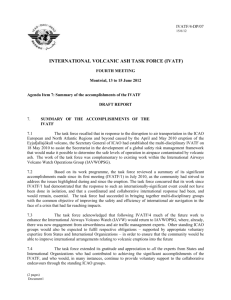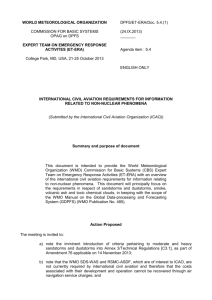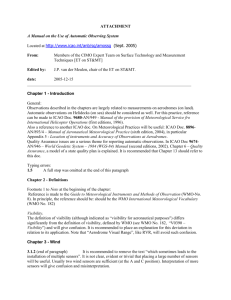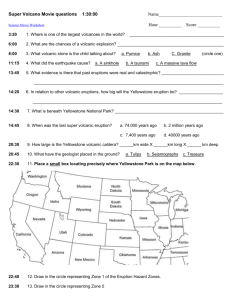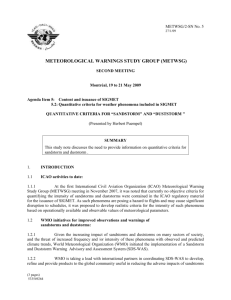ICAO requirements related to non-Nuclear ERA
advertisement
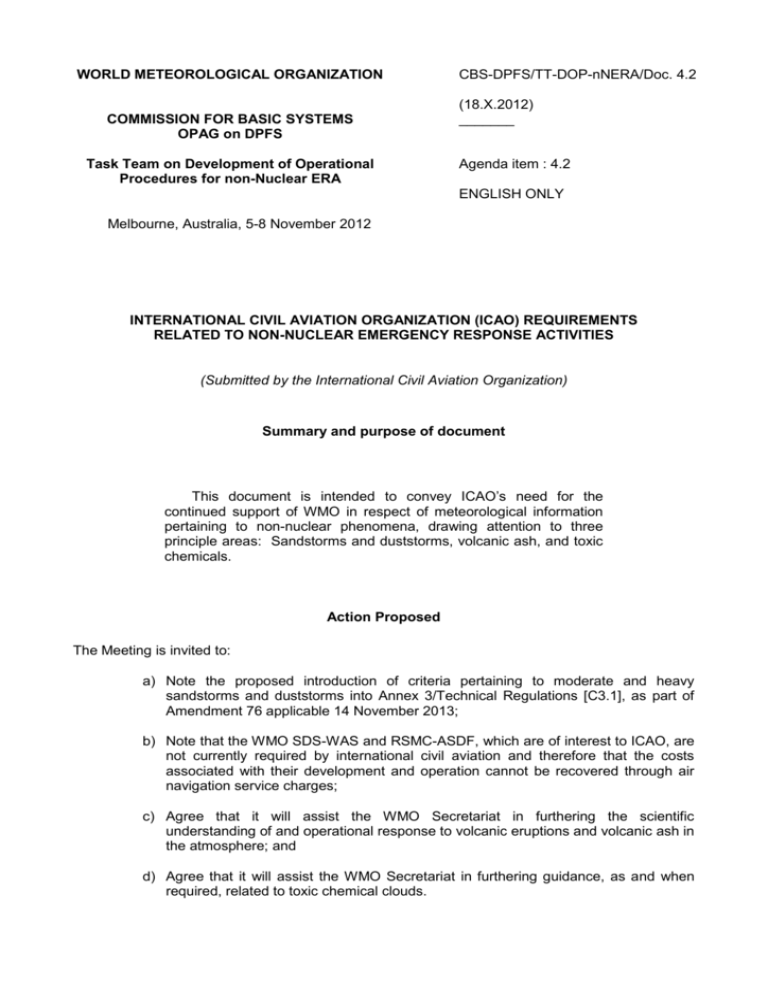
WORLD METEOROLOGICAL ORGANIZATION COMMISSION FOR BASIC SYSTEMS OPAG on DPFS Task Team on Development of Operational Procedures for non-Nuclear ERA CBS-DPFS/TT-DOP-nNERA/Doc. 4.2 (18.X.2012) _______ Agenda item : 4.2 ENGLISH ONLY Melbourne, Australia, 5-8 November 2012 INTERNATIONAL CIVIL AVIATION ORGANIZATION (ICAO) REQUIREMENTS RELATED TO NON-NUCLEAR EMERGENCY RESPONSE ACTIVITIES (Submitted by the International Civil Aviation Organization) Summary and purpose of document This document is intended to convey ICAO’s need for the continued support of WMO in respect of meteorological information pertaining to non-nuclear phenomena, drawing attention to three principle areas: Sandstorms and duststorms, volcanic ash, and toxic chemicals. Action Proposed The Meeting is invited to: a) Note the proposed introduction of criteria pertaining to moderate and heavy sandstorms and duststorms into Annex 3/Technical Regulations [C3.1], as part of Amendment 76 applicable 14 November 2013; b) Note that the WMO SDS-WAS and RSMC-ASDF, which are of interest to ICAO, are not currently required by international civil aviation and therefore that the costs associated with their development and operation cannot be recovered through air navigation service charges; c) Agree that it will assist the WMO Secretariat in furthering the scientific understanding of and operational response to volcanic eruptions and volcanic ash in the atmosphere; and d) Agree that it will assist the WMO Secretariat in furthering guidance, as and when required, related to toxic chemical clouds. CBS-DPFS/TT-DOP-nNERA/Doc. 4.2, p. 2 Reference(s): - ICAO Annex 3 – Meteorological Service for International Air Navigation/WMO Technical Regulations [C3.1]; - ICAO Handbook on the International Airways Volcano Watch – Operations Procedures and Contact List (Doc 9766; - ICAO Manual on Volcanic Ash, Radioactive Material and Toxic Chemicals (Doc 9691); - ICAO manual on Flight Safety and Volcanic Ash – Risk Management of Flight Operations with Known or Forecast Volcanic Ash Contamination (Doc 9974); - WMO Technical Document No. 778. CBS-DPFS/TT-DOP-nNERA/Doc. 4.2, p. 3 1. INTRODUCTION 1.1 The requirements of international civil aviation for meteorological information are contained in ICAO Annex 3 — Meteorological Service for International Air Navigation / WMO Technical Regulations [C.3.1]. In this regard, and in the context of the WMO CBS Task Team on Development of Operational Procedures for non-Nuclear Emergency Response Activities, international civil aviation requires meteorological information on the occurrence or expected occurrence of: a) Obscurations (e.g. sand, dust, smoke, volcanic ash) and other phenomena (dust/sand whirls, funnel clouds (tornado or waterspout), duststorm, sandstorm), which are to be included by an aerodrome meteorological office in local routine and special reports and in METAR and SPECI; b) Low drifting dust or sand, blowing dust or sand, duststorm, sandstorm, funnel cloud (tornado or waterspout), which are to be included by an aerodrome meteorological office in aerodrome forecasts (TAF); c) Sandstorms, duststorms, rising sand or dust, volcanic ash (including deposition), tsunami, toxic chemicals and other phenomena, which are to be included by an aerodrome meteorological office in aerodrome warnings; d) Widespread sandstorm/duststorm, which are to be included by the world area forecast centres (WAFC) as an element of world area forecast system significant weather (WAFS SIGWX) forecasts; e) Sandstorms, duststorms and volcanic ash, which are to be included as an element of SIGMET information by meteorological watch offices (MWO) for flight information regions; and f) Volcanic ash, which is to be included by volcanic ash advisory centres (VAAC) in volcanic ash advisory information. 1.2 As the above clearly illustrates, there are requirements for meteorological information on the occurrence or expected occurrence of a range of non-nuclear phenomena – in particular sandstorms, duststorms, volcanic ash and toxic chemicals – which may result in the need for an emergency response activity depending on the severity and extent (actual or foreseen). Meteorological products issued in a timely and appropriate manner by meteorological offices are used by users – in particular airline operators, flight crew members, air traffic service units, search and rescue service units and airport managements – to make strategic and/or tactical operational decisions on the effective and safe mitigation of the hazard. 1.3 The purpose of this paper is to convey ICAO’s need for the continued support of WMO in respect of meteorological information pertaining to non-nuclear phenomena, drawing attention to three principle areas: Sandstorms and duststorms, volcanic ash, and toxic chemicals. CBS-DPFS/TT-DOP-nNERA/Doc. 4.2, p. 4 2. DISCUSSION 2.1 Sandstorms and duststorms 2.1.1 As illustrated at 1.1 above, information on the occurrence or expected occurrence of sandstorms and duststorms is necessary to enable aerodrome meteorological offices, meteorological watch offices and others prepare and issue a range of meteorological products, including local reports, forecasts and warnings, which are to be used by a range of civil aviation users in order to make strategic and/or tactical operational decisions. 2.1.2 By and large, Annex 3/Technical Regulations [C3/1] requirements concerning sandstorms and duststorms have remained static for a number of years. Amendment 76 to Annex 3/Technical Regulations [C3.1] – with intended applicability on 14 November 2013 – proposes the introduction of criteria defining moderate and heavy sandstorms and duststorms, under Appendix 6, 4.2.9. The proposed criteria, developed in consultation with WMO, will assist meteorological watch offices in the preparation of SIGMET (and AIRMET) information for flight information regions. The proposed criteria are reproduced below for information. : 4.2.9 Recommendation.— Sandstorm/duststorm should be considered: a) heavy whenever the visibility is below 200 m and the sky is obscured; and b) moderate whenever the visibility is: 1) below 200 m and the sky is not obscured; or 2) between 200 m and 600 m. The group should note that Amendment 76 to Annex 3 is subject to adoption by the ICAO Council in early 2013 prior to applicability in November 2013. 2.1.3 The Fifteenth Session of the WMO Commission for Basic Systems (CBS-XV, 10 to 15 September 2012, Jakarta, Indonesia), under Agenda Item 4.4, noted the results of the work of an ad-hoc joint CAS-CBS Task Team on Sand and Dust Storm Warning Assessment Systems (SDS-WAS), and agreed that there was a need to incorporate the mandatory functions and criteria for the designation of RSMC with activity specialization in Atmospheric Sand and Dust storm Forecasts (RSMC-ASDF) in the current version of the Manual on the GDPFS. In this regard, the CBS was presented with the nomination of a centre in Barcelona, Spain, to act as an RSMC-ASDF for northern Africa, Europe and the Middle East. 2.1.4 In principle developments such as SDS-WAS and RSMC-ASDF are of interest to ICAO, since they can be expected to advance the (meteorological) capabilities of States where sandstorms and duststorms occur, and could in the future be used to improve a meteorological watch offices capability to prepare SIGMET (and AIRMET) information. However, such support is not currently required by international civil aviation and therefore should not be included in air navigation service charges until such time that a specific need is expressed by ICAO. 2.2 Volcanic ash 2.2.1 Recent years have seen considerable progress in the scientific understanding and operational response to volcanic eruptions and volcanic ash in the atmosphere, in particular following the eruptions of the Eyjafjallajökull and Grimsvötn volcanoes in Iceland in 2010 and 2011 respectively and the eruption of the Puyehue-Cordon Caulle volcano in Chile in 2011. CBS-DPFS/TT-DOP-nNERA/Doc. 4.2, p. 5 2.2.2 An International Volcanic Ash Task Force (IVATF) was established by ICAO in close consultation with WMO during the Eyjafjallajökull eruption to urgently address the issues that had caused significant disruption to civil aviation in Europe, the North Atlantic and beyond. Over a period of 2 years, and complementary to an existing ICAO International Airways Volcano Watch Operations Group (IAVWOPSG), the IVATF worked on approximately 40 tasks to advance the scientific understanding and operational response to volcanic eruptions and volcanic ash in the atmosphere. 2.2.3 As a result of this international effort, provisions and guidance has been developed or improved, intended to minimise, to the extent possible, the disruption caused by future eruption, wherever and whenever they may occur 2.2.4 In respect of updated provisions, Amendment 76 to Annex 3/Technical Regulations [C3.1], applicable 14 November 2013, proposes the introduction of a requirement for States with active or potentially active volcanoes to ensure that the volcano observatory monitors these volcanoes – the existing provision only requires the monitoring of active volcanoes. A revision of ICAO’s air traffic control procedures when volcanic ash is reported or forecast is expected to become applicable in November 2014 through an amendment to PANS-ATM (Doc 4444). 2.2.5 In respect of updated guidance, the ICAO Handbook on the International Airways Volcano Watch – Operations Procedures and Contact List (Doc 9766) and Manual on Volcanic Ash, Radioactive Material and Toxic Chemicals (Doc 9691) have undergone comprehensive review and, where necessary, revision. In addition, new guidance in the form of a manual on Flight Safety and Volcanic Ash – Risk Management of Flight Operations with Known or Forecast Volcanic Ash Contamination (Doc 9974) has been published to provide guidance which States may recommend to operators and regulatory authorities where volcanic ash contamination may be a hazard for flight operations. 2.2.6 ICAO greatly appreciates the continued support of WMO and its Technical Commissions – in particular CAeM and CBS – in the continued advancement of the scientific understanding and operational (emergency) response to volcanic eruptions and volcanic ash in the atmosphere 2.3 Toxic chemicals 2.3.1 During the consultation of draft Amendment 75 to Annex 3 in 2009, Contracting States identified a need for guidance on the issuance of aerodrome warnings relating to toxic chemicals. It had been indicated, by States, that it was unclear what toxic chemicals exactly meant. Since there was limited expertise in the field of toxic chemicals within the ICAO Secretariat, the ICAO Air Navigation Commission agreed that WMO, as the expert body in this area, should be invited to prepare additional guidance on toxic chemicals which would assist States in the issuance of aerodrome warnings accordingly. 2.3.2 The group will be pleased to learn that following consultation with and assistance from WMO, appropriate guidance has been included in the ICAO Manual on Volcanic Ash, Radioactive Material and Toxic Chemicals (Doc 9691). The guidance highlights that airborne toxic chemicals are highly localised events and the associated hazardous effects are usually sudden and short-lived in nature. For this reason, they are dealt with typically at a local level to ensure adequate, immediate emergency response. Since the main potential impact at an aerodrome would be if the source of the chemical release was nearby, local arrangements within a State are considered to be the most efficient means to deal with the hazard. The new guidance in Doc 9691 cross-references to appropriate WMO guidance on emergency response activities contained within WMO Technical Document No. 778, in particular Annexes 8 (Guidance on response to chemical incidents - definition of requirements concerning chemical incidents), 9 (Role of national meteorological services (NMSs) in response to chemical incidents ) and 10 (Guidance for CBS-DPFS/TT-DOP-nNERA/Doc. 4.2, p. 6 development of the interface between a national meteorological service and other emergency response agencies in case of chemical incidents). 2.3.3 The assistance of WMO in the development of this new guidance is greatly appreciated by ICAO. 2.3.4 At the present time there are no changes proposed or envisaged to ICAO provisions concerning toxic chemical clouds and the notification to aviation users thereof. ICAO will continue to engage with WMO and its Technical Commissions should changes be determined necessary. 3. ACTION BY THE MEETING 3.1 The Meeting is invited to: a) Note the proposed introduction of criteria pertaining to moderate and heavy sandstorms and duststorms into Annex 3/Technical Regulations [C3.1], as part of Amendment 76 applicable 14 November 2013; b) Note that the WMO SDS-WAS and RSMC-ASDF, which are of interest to ICAO, are not currently required by international civil aviation and therefore that the costs associated with their development and operation cannot be recovered through air navigation service charges; c) Agree that it will assist the WMO Secretariat in furthering the scientific understanding of and operational response to volcanic eruptions and volcanic ash in the atmosphere; and d) Agree that it will assist the WMO Secretariat in furthering guidance, as and when required, related to toxic chemical clouds. —————
